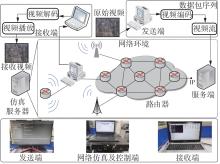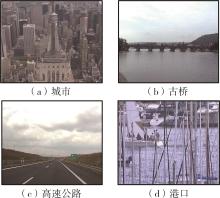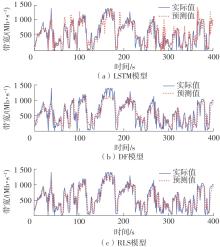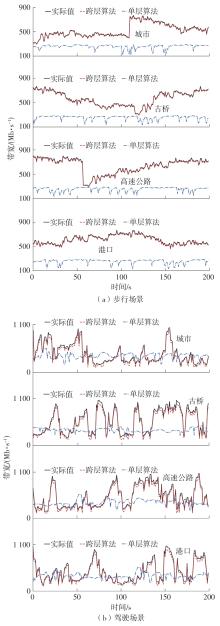Journal of South China University of Technology(Natural Science Edition) ›› 2023, Vol. 51 ›› Issue (11): 18-27.doi: 10.12141/j.issn.1000-565X.220705
Special Issue: 2023年电子、通信与自动控制
• Electronics, Communication & Automation Technology • Previous Articles Next Articles
Multidimensional Cross-Layer Bandwidth Prediction for Low-Latency Real-Time Video
CHEN Feng MAO Haobin CAI Jiling HUANG Xiangjun
- College of Physics and Information Engineering,Fuzhou University,Fuzhou 350108,Fujian,China
-
Received:2022-10-25Online:2023-11-25Published:2023-04-04 -
About author:陈锋(1984-),男,博士,副教授,主要从事视频传输、深度强化学习研究。E-mail:chenf@fzu. edu. cn -
Supported by:the National Natural Science Foundation of China for Youths(61801120);the General Program of the Natural Science Foundation of Fujian Province(2022J01551)
CLC Number:
Cite this article
CHEN Feng, MAO Haobin, CAI Jiling, et al.. Multidimensional Cross-Layer Bandwidth Prediction for Low-Latency Real-Time Video[J]. Journal of South China University of Technology(Natural Science Edition), 2023, 51(11): 18-27.
share this article
Table 1
Prediction error at different additional link delays"
| 时延/ms | 视频序列 | RMSE | R2 | ||
|---|---|---|---|---|---|
| 步行场景 | 驾驶场景 | 步行场景 | 驾驶场景 | ||
| 0 | City | 10.141 | 35.430 | 0.987 | 0.960 |
| Bridge | 12.128 | 36.549 | 0.975 | 0.967 | |
| Highway | 13.707 | 39.629 | 0.972 | 0.958 | |
| Harbour | 10.389 | 32.512 | 0.994 | 0.962 | |
| 50 | City | 14.774 | 100.899 | 0.852 | 0.831 |
| Bridge | 14.178 | 92.122 | 0.860 | 0.846 | |
| Highway | 14.709 | 104.417 | 0.865 | 0.820 | |
| Harbour | 16.380 | 98.242 | 0.851 | 0.843 | |
| 100 | City | 20.146 | 137.509 | 0.741 | 0.661 |
| Bridge | 17.286 | 130.625 | 0.798 | 0.675 | |
| Highway | 20.210 | 139.996 | 0.752 | 0.654 | |
| Harbour | 19.318 | 131.605 | 0.787 | 0.669 | |
| 1 | ARSAN T .Review of bandwidth estimation tools and application to bandwidth adaptive video streaming[C]∥Proceedings of High Capacity Optical Networks and Emerging/Enabling Technologies.Istanbul:IEEE,2012:152-156. |
| 2 | JIANG J, SEKAR V, ZHANG H .Improving fairness,efficiency,and stability in HTTP-based adaptive video streaming with festive[J].IEEE/ACM Transactions on Networking,2014,22(1):326-340. |
| 3 | YIN X, JINDAL A, SEKAR V,et al .A control-theoretic approach for dynamic adaptive video streaming over HTTP[C]∥ Proceedings of the 2015 ACM Confe-rence on Special Interest Group on Data Communication.New York:ACM,2015:325-338. |
| 4 | HE Q, DOVROLIS C, AMMAR M .On the predictabi-lity of large transfer TCP throughput[J].Computer Networks,2007,51(14):3959-3977. |
| 5 | MIRZA M, SOMMERS J, BARFORD P,et al .A machine learning approach to TCP throughput prediction[J].IEEE/ACM Transactions on Networking,2010,18(4):1026-1039. |
| 6 | SUN Y, YIN X, JIANG J,et al .C S2P:improving video bitrate selection and adaptation with data-driven throughput prediction[C]∥ Proceedings of the 2016 ACM SIGCOMM Conference.New York:ACM,2016:272-285. |
| 7 | HIGUCHI T, SHINGU H, SHIMIZU N,et al .Real-time video streaming based on TFRC using communication logging for 5G HetNet[J].IEICE Transactions on Communications,2019,E102.B(8):1538-1546. |
| 8 | KHANGURA S K, AKIN S .Online available bandwidth estimation using multiclass supervised learning techniques[J].Computer Communications,2021,170:177-189. |
| 9 | BENTALEB A, BEGEN A C, HAROUS S,et al .Data-driven bandwidth prediction models and automated model selection for low latency[J].IEEE Transactions on Multimedia,2020,23:2588-2601. |
| 10 | POKHARKAR S R, WAGH S J, DESHMUKH S N .Machine learning based predictive mechanism for internet bandwidth[C]∥ Proceedings of 2021 the 6th Inter-national Conference for Convergence in Technology.Maharashtra:IEEE,2021:1-4. |
| 11 | MEI L, HU R, CAO H,et al .Realtime mobile bandwidth prediction using LSTM neural network and Bayesian fusion[J].Computer Networks,2020,182:107515/1-11. |
| 12 | MEI L, GOU J, CAI Y,et al .Realtime mobile bandwidth and handoff predictions in 4G/5G networks[J].Computer Networks, 2022,204:108736/1-11. |
| 13 | RIBEIRO V J, RIEDI R H, BARANIUK R G,et al .PathChirp:efficient available bandwidth estimation for network paths [R].Washington D C:United States Department of Energy,2003. |
| 14 | KURDOGLU E, LIU Y, WANG Y,et al .Real-time bandwidth prediction and rate adaptation for video calls over cellular networks[C]∥ Proceedings of the 7th International Conference on Multimedia Systems.New York:ACM,2016:1-11. |
| 15 | SAMBA A, BUSNEL Y, BLANC A,et al .Instantaneous throughput prediction in cellular networks:which information is needed?[C]∥ Proceedings of 2017 IFIP/IEEE Symposium on Integrated Network and Service Management.Lisbon:IEEE,2017:624-627. |
| 16 | TAANI B, ZIMMERMANN R .Spatio-temporal analysis of bandwidth maps for geo-predictive video streaming in mobile environments[C]∥ Proceedings of the 24th ACM International Conference on Multimedia.New York:ACM,2016:888-897. |
| 17 | SLIWA B, FALKENBERG R, LIEBIG T,et al .Machine learning based context-predictive car-to-cloud communication using multi-layer connectivity maps for upcoming 5G networks [C]∥ Proceedings of 2018 IEEE the 88th Vehicular Technology Conference.Chicago:IEEE,2018:1-7. |
| 18 | YUE C, JIN R,SUH K,et al .LinkForecast:cellular link bandwidth prediction in LTE networks[J].IEEE Transactions on Mobile Computing,2017,16(7):1582-1594. |
| 19 | MINOVSKI D, ÖGREN N, MITRA K,et al .Throughput prediction using machine learning in LTE and 5G networks[J].IEEE Transactions on Mobile Computing,2023,22(3):1825-1840. |
| 20 | RIKIĆ B, SAMARDŽIJA D, ČADOVSKI O,et al .Cellular network bandwidth prediction in consumer applications[C]∥ Proceedings of 2021 IEEE International Conference on Consumer Electronics.Las Vegas:IEEE,2021:9427757/1-3. |
| 21 | ČADOVSKI O, ILIĆ V, RIKIĆ B,et al .Proposal for bandwidth prediction using hybrid division model[C]∥Proceedings of 2021 IEEE International Conference on Consumer Electronics.Las Vegas:IEEE,2021:9427751/1-2. |
| 22 | NARAYANAN A, RAMADAN E, MEHTA R,et al .Lumos5G:mapping and predicting commercial mmWave 5G throughput[C]∥ Proceedings of the ACM Internet Measurement Conference.New York:ACM,2020:176-193. |
| 23 | RACA D, LEAHY D, SREENAN C J,et al .Beyond throughput, the next generation:a 5G dataset with channel and context metrics[C]∥ Proceedings of the 11th ACM Multimedia Systems Conference.New York:ACM,2020:303-308. |
| 24 | HAARNOJA T, ZHOU A, HARTIKAINEN K,et al .Soft actor-critic algorithms and applications[EB/OL].(2019-01-29)[2022-10-20].. |
| 25 | CHRISTODOULOU P .Soft actor-critic for discrete action settings[EB/OL].(2019-10-18)[2022-10-20].. |
| 26 | 迈思源 .Holowan网络损伤仿真仪[EB/OL].(2020-01-12)[2022-10-20].. |
| 27 | ZHOU Z H, FENG J .Deep forest[J].National Science Review,2019,6(1):74-86. |
| 28 | HAYKIN S .Adaptive filter theory[M].4 ed.Delhi:Pearson Education,2002. |
| 29 | WAHAB A, AHMAD N, SCHORMANS J .Variation in QoE of passive gaming video streaming for different packet loss ratios[C]∥ Proceedings of 2020 the Twelfth International Conference on Quality of Multimedia Experience.Athlone:IEEE,2020: 1-4. |
| 30 | LAGHARI A A, LAGHARI R A, WAGAN A A,et al .Effect of packet loss and reorder on quality of audio streaming[J].EAI Endorsed Transactions on Scalable Information Systems,2020,7(24):1-7. |
| 31 | ADEYEMI-EJEYE A O, ALRESHOODI M, AL-JOBOURI L,et al .Impact of packet loss on 4K UHD video for portable devices[J].Multimedia Tools and Applications,2019,78:31733-31755. |
| 32 | AHMAD N, WAHAB A, SCHORMANS J .Importance of cross-correlation of QoS metrics in network emulators to evaluate QoE of video streaming applications[C]∥ Proceedings of 2020 the 11th International Conference on Network of the Future.Bordeaux:IEEE,2020:43-47. |
| [1] | ZHENG Juanyi, DONG Jiahao, ZHANG Qingjue, et al. Reconfigurable Intelligence Surface Channel Estimation Algorithm Based on RDN [J]. Journal of South China University of Technology(Natural Science Edition), 2024, 52(3): 102-111. |
| [2] | ZHANG Guangchi, LE Wenying, PANG Haijian, et al. Transmit Power Minimization Algorithms for IRS-Assisted Cognitive Simultaneous Wireless Information and Power Transfer Networks [J]. Journal of South China University of Technology(Natural Science Edition), 2023, 51(3): 110-123. |
| [3] | LIU Jiaojiao, CHEN Ayue, MA Biyun. Rate Adaptation in Multiple Access Based on DS-UsWB Body Communication [J]. Journal of South China University of Technology(Natural Science Edition), 2023, 51(3): 91-97. |
| [4] | WU Haowei, HUANG Fengjiao, YAN Lian, et al. Legitimate Eavesdropping Scheme for Suspicious Relay Communication Networks [J]. Journal of South China University of Technology(Natural Science Edition), 2022, 50(10): 70-79. |
| [5] | LI Song, YU Yi, SUN Yanjing, et al. Mobile Virtual Reality-Orinted Partial Cached Contents Sharing Methods [J]. Journal of South China University of Technology (Natural Science Edition), 2021, 49(6): 122-130,140. |
| [6] | CHEN Zhi-jian CAI Min. Design of Anti-Interference High-Linearity RF Front-End [J]. Journal of South China University of Technology (Natural Science Edition), 2016, 44(1): 37-43. |
| [7] | Liu Jiao-jiao Ma Bi-yun. Dynamic Rate Allocation of Heterogeneous Wireless Transmission Based on Coalition Formation Game Theory [J]. Journal of South China University of Technology (Natural Science Edition), 2015, 43(9): 27-33. |
| [8] | Pan Wei-qiang Hu Shao-dong Liu Jing. Energy Efficiency-Based Cell Switch On-Off Strategy Under Heterogeneous Services [J]. Journal of South China University of Technology (Natural Science Edition), 2015, 43(5): 30-34. |
| [9] | Lang Gai- ping Xu Yu- bin Ma Lin. Selection Algorithm of Heterogeneous Networks Based on Non- Cooperative Game Theory [J]. Journal of South China University of Technology (Natural Science Edition), 2014, 42(5): 29-35. |
| [10] | Gu Jun Zhong Yuan- hong Zhang Zhen- yu Zeng Fan- xin. Interference Suppression for Multi- Cell Multi- User MIMO Systems [J]. Journal of South China University of Technology (Natural Science Edition), 2013, 41(6): 42-46. |
| [11] | Liu Jiao-jiao Cao Yan. Rate Allocation Based on Pricing Function of Cooperative Access to Wireless Random Networks [J]. Journal of South China University of Technology(Natural Science Edition), 2012, 40(6): 22-28. |
| [12] | Shi Xiao-ye Ge Jian-hua Li Jing Gao Yang. Design and Performance of C-HARQ Schemes for Full Diversity Cooperation Transmission System [J]. Journal of South China University of Technology (Natural Science Edition), 2011, 39(9): 108-114. |
| [13] | Zhou Xiao-ming Lai Sheng-li. Numerical Simulation of the Interaction Between the Three-dimension Rotated Human Head Model and Handset monopole Antenna [J]. Journal of South China University of Technology(Natural Science Edition), 2004, 32(5): 30-33. |
| [14] | Zhou Xiao-ming Lai Sheng-Li. Numerical Simulation of Interaction System Between Monopole Handset and Layered Human Head Model [J]. Journal of South China University of Technology(Natural Science Edition), 2003, 31(12): 5-8. |
| [15] | Zhu Ning-xi Zhang Qi . Realization of GSM Network Short Message Wireless Communication SCADA System [J]. Journal of South China University of Technology(Natural Science Edition), 2003, 31(12): 9-12. |
| Viewed | ||||||
|
Full text |
|
|||||
|
Abstract |
|
|||||











